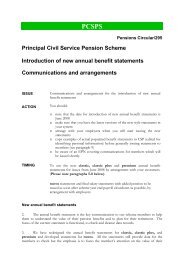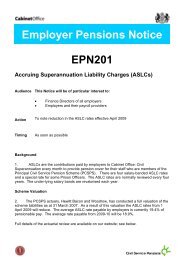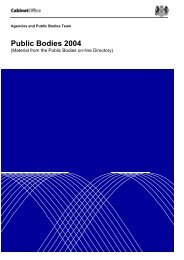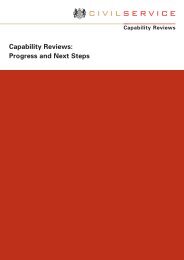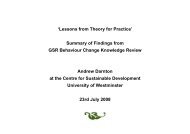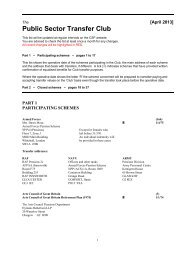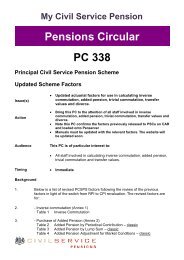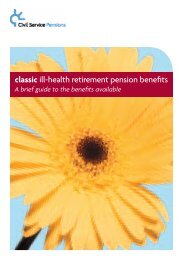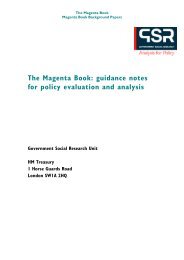Making Car Sharing and Car Clubs Work - Case ... - The Civil Service
Making Car Sharing and Car Clubs Work - Case ... - The Civil Service
Making Car Sharing and Car Clubs Work - Case ... - The Civil Service
Create successful ePaper yourself
Turn your PDF publications into a flip-book with our unique Google optimized e-Paper software.
MAKING CAR SHARING AND CAR CLUBS WORKCASE STUDY SUMMARIESSupport/Consultation21.30 <strong>The</strong> scheme was developed carefully, <strong>and</strong> benefited greatly from the experiences of <strong>Car</strong>Plusin getting the scheme off the ground. In addition, Jo Taylor, who worked for BioRegional,completed a Winston Churchill travelling scholarship examining car clubs across Europe <strong>and</strong>North America, <strong>and</strong> has used this experience to suggest further enhancements to thescheme.21.31 Consultation remains a strong component of the scheme, with on-going user <strong>and</strong> non usersurveys, <strong>and</strong> communication sessions, to ensure the car club continues to offer the rightproduct <strong>and</strong> level of service.User Perceptions21.32 <strong>The</strong> scheme has strong support from it’s members, with high utilisation rates for all vehicles.All of the users interviewed as part of this study provided strong praise for the scheme <strong>and</strong>had significantly changed their travel behaviour. 2 of the 3 users had given up a car as adirect result of membership, <strong>and</strong> had not suffered any accessibility problems as a result.Those that had given up their car travelled at least 50% less miles, <strong>and</strong> had noticed areduction in overall trip making activity (more thought was given to each trip, <strong>and</strong> whethertrips could be more appropriately combined).21.33 In all cases, the motivations were a combination of environmental awareness <strong>and</strong> financialsavings (in all cases the financial savings had been realised as a result of car clubmembership, <strong>and</strong> had not been identified from the outset).21.34 All users perceived the technology to be reliable, <strong>and</strong> welcomed the newness <strong>and</strong>cleanliness of the vehicle fleet. <strong>The</strong> ease of use, <strong>and</strong> not having the hassles of carownership (insurance, breakdown etc..) were all considered to be important aspects of thescheme. Similarly, the availability of vehicles was seen as excellent (<strong>and</strong> important), <strong>and</strong>only on a couple of occasions had users not been able to book a vehicle (in all of thesecases, a vehicle was sourced from the London City <strong>Car</strong> Club parking bays in Wallington).21.35 Other issues raised by the users included:<strong>The</strong> acceptance that car clubs offer a ‘pay as you go’ service, hence requires a changein lifestyle choice.Recognition of the carbon savings that were being made as a result of publicity <strong>and</strong>their own awareness of reduced trips.Felt that more should be done to promote car clubs including use of bus lanes, taxexceptions, increased dedicated parking bays, <strong>and</strong> wider choice of vehicles exemptfrom congestion charging.<strong>The</strong> importance of employer payments for membership (e.g. BioRegional pay groupmembership for all staff)Improved information on the benefits of car club membership (including the possibilityof comparing trip costs using different modes at the time of booking)Final V1.1, Dec. 2004 - 127 -




